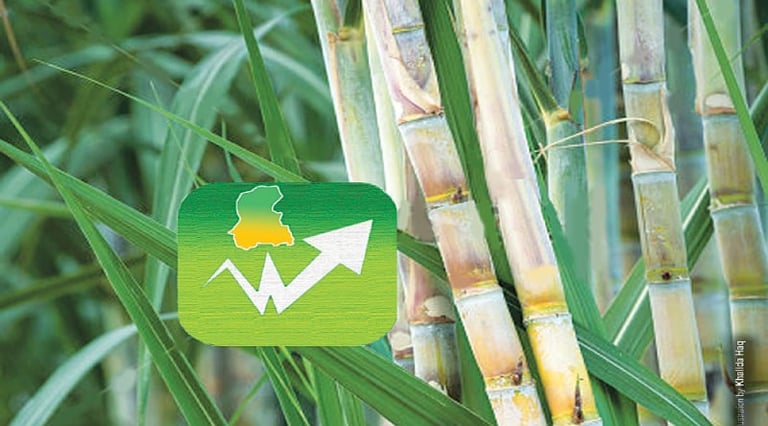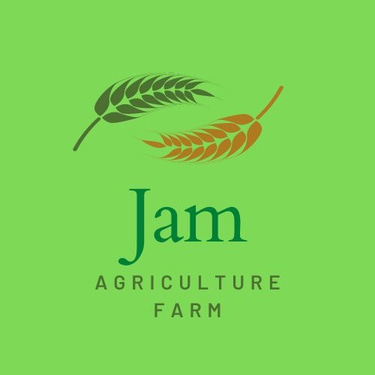Sugarcane Farming
Sugarcane is an important crop in Pakistan, both economically and culturally. It is one of the country's major cash crops and is grown on a large scale in the Punjab and Sindh provinces.
AGRICULTURE
Sugarcane farming
Sugarcane is an important crop in Pakistan, both economically and culturally. It is one of the country's major cash crops and is grown on a large scale in the Punjab and Sindh provinces. The crop provides the raw material for the sugar industry, which is a major source of revenue for the country. Additionally, sugarcane is used to produce other products such as molasses, ethanol, and bagasse (the dry pulpy residue left after juice extraction), which are used in industries like textiles, paper, and power generation. It also creates job opportunities for farmers, labourers and its by-products used in other industries.
Moreover, sugarcane is also an important crop in terms of the livelihoods and food security of many smallholder farmers and rural communities in Pakistan. It also forms an essential item for industries like sugar, chipboard, paper, barrages, and confectionery uses in chemicals, plastics, paints, synthetics, fiber, insecticides and detergents. Sugarcane production in the country has increased over time. Despite expansion in production over years, increase in the productivity per unit of area has been very low in Pakistan. The average sugarcane production in the country required static between 45-50 tons/ha, which is very low compared to the cane-producing other countries. The average yield of sugarcane in the world is around 60 metric tons/ha, while India and Egypt are getting around 66 tons and 105 tons/hectare, respectively. In this way, Egypt with the highest cane yield in the world is getting about 142 per cent high-yield than Pakistan. India with almost similar soil and climatic conditions is obtaining about 53 per cent higher cane yield than Pakistan.
As it is one of the cash crops of the country, hence, efforts should be made to get substantial improvement in its yield. Our sugar yield and sugar recovery (%) are less than half of the developed cane-growing countries of the world. Some of the measures to bring down the cost of cultivation and improve cane productivity include the selection of the right varieties, maintenance of soil health, quality planting material, nutrient management, weed management, water management and proper post-harvest handling.
Role of Grower: Grower is the main key factor that can help to increase sugarcane production from the field. In Pakistan, most of the growers don’t know the proper method of sugarcane cultivation. Hence the cane produced is of no good quality and we have less cane and sugar recovery. So it is necessary that there should be organizations that should guide the growers to increase their production.
Here are some of the steps that can improve sugarcane production.
Land preparation: Sugarcane is a deep-rooted crop and proper land preparation plays an important role in the development of the cane root system, and achieving optimal growth of the crop. Land should be prepared by deep ploughing. The soil should be disked. The soil in the prepared field should be friable and well worked so that full germination takes place and later on plants grow without any inhibiting barriers (compact sub-soil layer).
Farmyard Manure: It is very important that well-rotten farmyard manure (FYM) should be applied a month prior to land preparation. Press mud from the sugar industry is another excellent source of organic matter and nutrients. Green manuring can also serve a purpose.
Soil Insect Control at Planting Time: Growers must keep in mind the practices they can use to decrease the possibility of soil insect damage. Only two crop conditions require the use of a soil insecticide in sugarcane fields and usually only in sandy soils. These are: (a) When pasture, turf or grass-infested land is brought into cane production for the first time or after being out of cane production for several years. (b) When cane fields are extremely grassy, particularly when the cane is planted in a field that was not kept free of heavy grass infestation when fallow. Ongoing wireworm and white grub infestations will persist in grassy fields. Again, this may be needed only on light or mixed soils.
Growers must consider control measures for soil insects at planting time and base chemical control on verification of soil insect pest infestations. Based on new research data, the economic threshold is slightly above one wireworm per bait sample before planting.
Sowing Season
The selection of an appropriate planting method and schedule greatly influences crop growth, maturity, and yield. Since low temperature and moisture stress are detrimental to germination, the planting season in subtropical regions is preferably spring. But in areas where winter is severe enough to restrict growth or even kill sugarcane, planting material may only be available in autumn, thus necessitating pre-winter planting.
In tropical regions, particularly where irrigation is not practised, a sufficiently moist season should be selected for planting. There are two planting seasons: fall and spring. Fall planting starts from the first week of September and continues to mid-October in Punjab and Sindh. Spring planting starts in mid-February and lasts until the end of March. These planting times are strictly observed because late planting can reduce the yield by as much as 30 per cent.
Appropriate seed rate and spacing are often overlooked by farmers, with the result that the optimal plant population is not achieved, which is the key factor in sugarcane production. The seed rate and spacing between rows differ with variety. Thick-cane cultivars like 'BL-4', 'Triton', and 'PR-1000' require a higher seed rate and more space between the rows than thin and medium-cane varieties. Four to Five tonnes of stripped cane per acre for thick varieties and Three to Four tones for medium to thin varieties is sufficient to produce a desired plant population of about 80 thousand canes/acre. A spacing of 1 m between the rows of thick varieties, and 0.60-0.75 m for thin to medium varieties allows sufficient space for operations like intercultural and earthing up.
Seed Rate
Upper Sindh 80-100 mds/acre or 30000-40000 buds/acre
Middle Sindh 80-100 mds/acre or 30000-40000 buds/acre
Lower Sindh 80-100 mds/acre or 30000-40000 buds/acre
Planting Pattern
Sugarcane may be planted at a row spacing of 90 cm to 1 m. Two budded double sets should be placed end to end in the furrows covered with a 2 to 3 cm soil layer. About 3.2 to 4 tonnes of seed (80 to 100 maunds) of thin cane varieties and 4 to 5 tonnes of seed (100 to 120 maunds) of thick varieties are sufficient to plant one acre. It is evident that yield increases in production and sugar per acre when the planted row was widened to the 15- to 18-inch furrow. Growers who can successfully handle the 24-inch width furrow are encouraged to do so. It is also suggested that the furrow opener be constructed to leave a wide bottom with a slight indentation on each side of the furrow and a slight ridge of loose soil in the middle of the furrow bottom.
Varieties
Practice healthy seeds of improved varieties of sugarcane. Which can increase cane yield from 20 to 25 per cent. The Sugarcane varieties recommended are given below:
CP-43-33,
CP- 77-400,
CP 81-1435,
ABT super,
BF–162,
SPSG – 26,
SPF – 234,
BL – 4,
T - 10
Recommended varieties of Sugarcane.
Lower Sindh (areas south to Hyderabad) Early maturing: BL –4 Mid-season: PR –1000, BF –129. Late maturing: NIA-98 Upper Sindh (areas north of Hyderabad). Early maturing: BL-4, L –113, L –116, TRITON, SPSG-26. Late maturing: NIA-98. BL-4 variety flourishes very well in heavy fertile and well-drained soil with good irrigation. As the variety occupied good fields, it established high yields. The new variety BF-12 is yet in the stage of multiplication, while SPSG -26 and Th-10, have just been introduced.
Fertilizer application
According to a survey, the farmers are using one-fourth of chemical fertilizers against the sugarcane crop requirements due to the non-availability of fertilizers and the high cost of the same. This haphazard use of fertilizer brings no fruit and therefore the farmers do not get the crops to their expectations. Getting the soil tested before the use of any particular fertilizer is not practised in our country. As mentioned earlier, fertilizer use in Pakistan is imbalanced and inadequate. Most of the cane growers in the country use only nitrogenous fertilizers while others use an imbalanced combination of N and P. Use of K is almost neglected in cane crop.
Fertilizer recommendations for sugarcane are given below.
NP/2O/ K/2O Urea DAP MOP/SOP
70-110 50 50-70 2.25-4 2.25 2.5 / 2-3
All phosphorus, potash, and one-fourth N should be applied when planting. It is preferable that P and K may be applied in furrows where seed sets are to be placed. The rest of the nitrogenous fertilizer may be applied in three equal splits i.e. during April, May and by mid-June to February-March planted crop.
Soil Testing
The best way to define lime, phosphorus and potassium requirements is with a reliable soil test. The soil sample must be collected accurately for the test to be valid. Large fields should be broken up into smaller units for sampling purposes, and the smaller fields intensively sampled, because nutrient and pH levels often vary greatly within fields. Intensive, thorough sampling is the only way to detect these variations and adjust fertilizer and lime rates accordingly. Medium to heavy, pH 5.0-8.5. Liming is required if pH < 5, or gypsum if pH > 9.5.
Weed control
Good land preparation is a key factor in controlling weeds. For proper weed control, Gesapax combi (80 WP) may be applied @ 1.4 kg per acre in medium textured soils and @ 1.8 kg per acre in heavy soils in 100 to 120 litres of water. The weedicide should be used with the advice of technical experts.
Irrigation
It is important to take care of the irrigation requirements of sugarcane, particularly in the summer months. Farmers must plan their acreage to be planted under cane crop according to the available water at their farm. Keep in mind that each field should get at least 16 to 20 irrigations during the crop year adjusting the irrigation schedule according to rainfall in summer.
Table of Irrigation Schedule:
March-April: 12-14 days
May-June: 8-10 days
July-August: 10-15 days (if there is no rainfall, irrigation interval should be 8-10 days)
September-October: 15-20 days
November-December: 25-30 days
Control of diseases
For controlling sugarcane diseases, use healthy seeds and preferably plant disease-resistant varieties. Treat the seed with fungicide before planting. The diseased plants from the field should be removed and either buried or burnt.
Harvesting
Stop irrigation 25 to 30 days before harvesting of crop and do not leave the harvested crop for long in the field. In case it has to be kept for a prolonged period, it should be covered with trash. Different varieties planted may be harvested according to their maturity. Harvesting of early maturing varieties may be started during November, mid-season varieties during December and the late maturing varieties during January. The crop harvested during February-March gives good ratoon crop. When the stem is close to the surface, great vigilance is required in order to cut the maximum portion of the stem, which is valuable both for its weight and sugar content. The harvested cane should be immediately hauled to the mill otherwise weight and sucrose losses may occur. For this purpose, transport should be arranged in advance.




